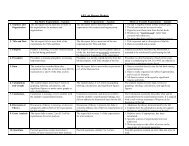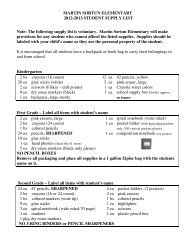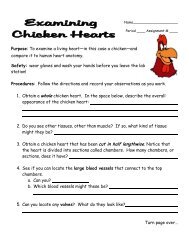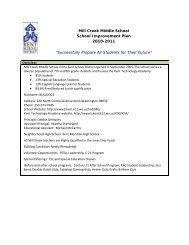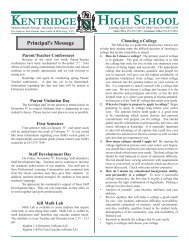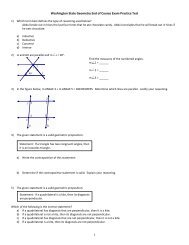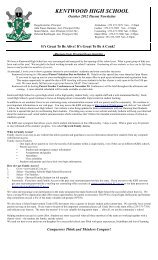Circulatory System Gizmo circulationgizmo.pdf - Kent
Circulatory System Gizmo circulationgizmo.pdf - Kent
Circulatory System Gizmo circulationgizmo.pdf - Kent
Create successful ePaper yourself
Turn your PDF publications into a flip-book with our unique Google optimized e-Paper software.
Extension:<br />
What’s in your<br />
blood?<br />
Get the <strong>Gizmo</strong> ready:<br />
Take a blood sample from any blood vessel using<br />
the syringe.<br />
Question: What is inside blood?<br />
1. Observe: Look at the Microscopic view of<br />
blood sample. Sketch what you see in the<br />
space at right. (If you like, you could also<br />
click the camera icon to take a <strong>Gizmo</strong><br />
snapshot, and then paste your snapshot into<br />
a blank word-processing document.)<br />
Find and label the following objects in your<br />
sketch:<br />
Red blood cells (small, round cells that carry oxygen)<br />
White blood cells (large, irregular cells that fight disease)<br />
Platelets (tiny fragments that help to stop bleeding when you are cut)<br />
2. Collect data: Blood carries many vital substances. Four of these are listed above the<br />
Microscopic view. Oxygen and sugar are needed by all body cells. Carbon dioxide and<br />
urea are waste products. What are the concentrations of each substance in this sample?<br />
Oxygen: _________ Carbon dioxide: _________ Sugar: _________ Urea: _________<br />
3. Investigate: Take samples of blood from all over the body. Try to determine where sugar<br />
enters the blood, and where it is removed.<br />
A. Where does sugar enter the blood? ______________________________________<br />
B. How can you tell where sugar enters the blood? ____________________________<br />
___________________________________________________________________<br />
C. Where is sugar removed from the blood? __________________________________<br />
D. How can you tell? ____________________________________________________<br />
___________________________________________________________________<br />
4. Investigate: Take blood samples to determine where urea enters the blood and is removed.<br />
A. Where does urea enter the blood? _______________________________________<br />
B. Where is urea removed from the blood? ___________________________________<br />
Don’t forget to do the Assessment Questions below the <strong>Gizmo</strong> when you finish with the above<br />
activities! These are part of your grade!<br />
My Score ______/5




